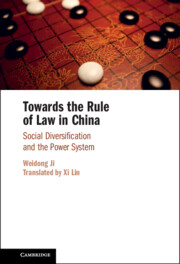Book contents
- Toward the Rule of Law in China
- Epigraph
- Toward the Rule of Law in China
- Copyright page
- Contents
- Foreword
- Acknowledgments
- Translator’s Note
- Abbreviations
- Introduction
- 1 The Conception of Law in Traditional China
- 2 The Essence of Modern Rule of Law
- 3 The Rule of Law: Contemporary Challenges and Paradigmatic Innovation
- 4 A Rule-of-Law Democracy (Rechtsdemokratie): Social Diversification and Reconstructing the System of Authority
- 5 Judicial Reform in China: The Status Quo and Future Directions
- 6 Reconstructing Legal Ideology
- Postscript
- Book part
- References
- Index
1 - The Conception of Law in Traditional China
Published online by Cambridge University Press: 24 February 2022
- Toward the Rule of Law in China
- Epigraph
- Toward the Rule of Law in China
- Copyright page
- Contents
- Foreword
- Acknowledgments
- Translator’s Note
- Abbreviations
- Introduction
- 1 The Conception of Law in Traditional China
- 2 The Essence of Modern Rule of Law
- 3 The Rule of Law: Contemporary Challenges and Paradigmatic Innovation
- 4 A Rule-of-Law Democracy (Rechtsdemokratie): Social Diversification and Reconstructing the System of Authority
- 5 Judicial Reform in China: The Status Quo and Future Directions
- 6 Reconstructing Legal Ideology
- Postscript
- Book part
- References
- Index
Summary
It has been argued that during the Western Zhou, Chinese monarchs adopted a multicentric governance model (Wu 2013, pp.137–57). The successive Spring and Autumn Period was a time marked by a collapse of rites and corruption of norms (礼崩乐坏), while the Warring States Period by great chaos of competing to be the hegemon. Both periods were characterized by a disruption of sociopolitical order en masse – a disruption so unsettling that Chinese history moved again toward the concentration of power and a unipolar model of political governance. Qinshi Huangdi, the emperor of Qin, unified China, ended its disunity, and created a highly centralized structure of political power. Lord Shang, a well-known minister in the unified Qin Empire, once suggested that “[o]nly when a sage rules the country will he strive for singleness of purpose.” The means to achieve this goal is by the law, with its guideline being a draconian legal system that is founded on strict reward and punishment. This effective control serves the purpose of building a sense of authority among the people. In the eyes of a legalist in ancient China, inasmuch as the monarch monopolizes power and uses it as an instrument for state governance, this can easily achieve its effectiveness. As Guanzi argued, “[m]ajesty cannot be wielded by two persons; government cannot have two gates. When a ruler uses laws to govern his country, he need only put them in place and that is all.” This practice of subjugating the law to political power has one archetype – Li Kui’s The Canon of Law (法经).
- Type
- Chapter
- Information
- Towards the Rule of Law in ChinaSocial Diversification and the Power System, pp. 15 - 33Publisher: Cambridge University PressPrint publication year: 2022

